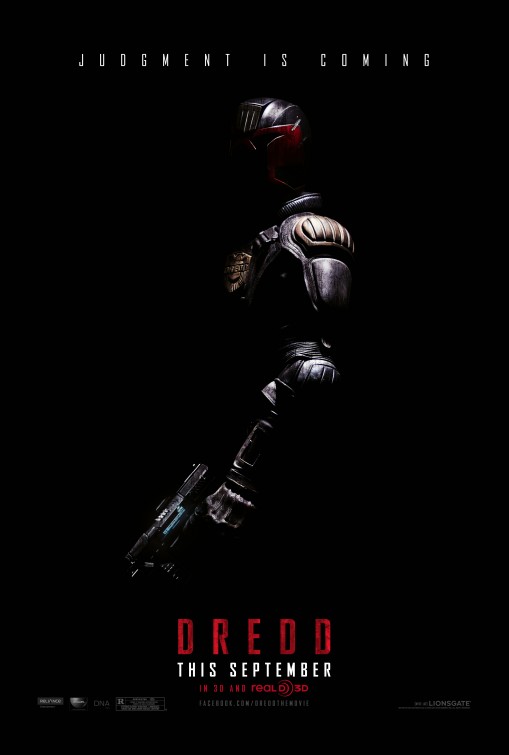Judgement Is Coming
Director
Pete Travis
Starring
Karl Urban
Olivia Thirlby
Lena Headey
Wood Harris
Trying to capture an entire comic book universe, especially one set in a dystopian future where half of the US east coast has been amalgamated into one huge sprawling crime-riddled city, is always difficult. Judge Dredd is one of those many properties that people claim to be unadaptable and unfit for cinema. Thankfully, Alex Garland’s script details a very stripped down approach with a two fold story. The opening sequence details the world of Mega-City One and the responsibility and authority of the Judges that police it but the real bulk of the narrative starts shortly after when Dredd investigates a simple homicide.
Shortly after the opening sequence, Judge Dredd [Urban] is assigned a trainee for assessment, Cassandra Anderson [Thirlby]. He notes that a fail is a fail, despite being only 3% below an acceptable pass rate and she should not be wearing a badge. Dredd’s supervisor explains that Anderson is in fact a mutant (after extreme radiation exposure since birth) and has developed telepathic powers, which they feel is of use. Going over the rules of the exercise, Dredd explains to Anderson that there are around sixteen thousand crimes reported every day, only six per cent of which can be responded to. As the exercise tests Anderson’s capabilities, he allows her to choose where to start. As such, they proceed to the 200 floor mega-block to investigate a triple homicide. The mega-block in question, Peach Trees, is a city in its own right and controlled by one gang, headed by scarred former prostitute, Ma-Ma [Headey]. It’s also the base of operations for the manufacturing and distribution of a new drug called slo-mo, which allows the user to experience the world at 1% its normal speed. Whilst investigating the three very public deaths, the Judges stumble across the existence of the Ma-Ma clan and the sway they hold over the building’s populace. As such, Ma-Ma locks the building down and orders everyone within to arm themselves and kill the Judges. With a cuffed suspect in tow, the Judges battle their way through the building both in an attempt to escape and exact justice.
Dredd is an unwavering fascist beacon of the law, operating without any consideration of a grey area. A man who doesn’t evolve as a character (not even over 35 years of comic book history) yet somehow inspires everyone around him. For lack of a better comparison, he’s a 1980’s action hero. So, when the comic was adapted in 1995, you can almost understand why they cast Sylvester Stallone in the lead role.. and to give that movie credit, the first five minutes are brilliant; everything after that is horse piss. Where this new adaptation succeeds is by stripping down to the basics of the comic and the character and simply showing us a day in the life of a Judge, whilst simultaneously feeding us an interesting narrative. That and it’s written by Alex Garland, who is a fan of 2000AD’s Judge Dredd comic. Utilising this basic structure, Dredd feels reminiscent of 80’s dystopian flicks, drawing heavily on Escape From New York, Die Hard, Dirty Harry, Mad Max and Robocop… not to mention the actual source material itself.
Visually, the film is extremely impressive, portraying a plausible future much like the one in Total Recall remake. Furthermore, the slo-mo effect offers both an enticing visual and actually replicates the concept of being on drugs, namely the analysis and fascination with minute details, experienced in over-saturated, high definition tones. This effect also produces a curious art form – aesthetically beautiful death. As a gimmick, it could have been forced down the audience’s throats or used excessively; the ultimate crime would have been to produce a scenario where Dredd would take the drug or some bollocks. Used sparingly, it creates fascinating imagery, dissects the destructive power of weaponry and allows us to experience a brief moment of horrific terror and pain as one of vibrant colour and visceral saturation. With so many studios paranoid about losing money and key audiences being children and teenagers, it’s a bit of a rarity to see a solid adult action film that isn’t marketed to thirteen year olds. If you’re going to make a film about a dystopian future where murder, rape and drugs run rampant, you need to show that world in all its scummy gritty glory. Much like the ’95 attempt, this film would never have worked in a dumbed down, muted way; equally, 300 could have only been as violent as it was and its success proved a point – if the film is good, people will watch it.
You may have noticed that when noting praise I have been quick to mention Garland and said nothing of Travis. This is largely due to the unorthodox collaboration between the two and the strange hybrid of talent that I think will probably see writer Alex Garland as the clear visionary, rather than director, Pete Travis. Speaking of talent, given the budget and setting the cast is fairly small but has individuals of significant note. Firstly, Urban embodies Dredd perfectly. His performance is utterly egoless and transformative yet still entertaining, rarely veering into absurd territory. Initially, Thirlby feels very out of place with her pristine looks and beaming innocence – a crime I usually berate Michael Bay for – but as the film progresses we realise that she is far from helpless and her growth and arc help make Dredd (and the other faceless Judges) a relatable character. Then we have the two key antagonists, Lena Headey and Wood Harris; two exceptional choices considering their respective successes in strong villainous roles – namely Cersei Lannister from Game Of Thrones and Avon Barksdale from The Wire. On top of all that, we have a sea of tattooed, pierced and grimy extras who really sell the brutal and hostile existence within the mega-blocks.
Finally, a word about Paul Leonard-Morgan’s score which draws on 80’s concepts and structures conditioned and processed with contemporary instruments and programmes to give a genuinely plausible futuristic soundtrack. Having said that, the inclusion of Matt Berry’s Snuff Box theme was a nice little nod to a little known British series (a series which I am a massive fan) but for that reason I found it incredibly jarring. But if you had no knowledge of the series, I doubt it would even register as out of place. Overall, the film is a surprisingly entertaining analysis of a possible future and I would happily welcome any number of sequels that Garland would care to pen, providing Urban returns to the lead role.
Release Date:
7th September 2012
The Scene To Look Out For:
Much like Die Hard, the real pay-off scenes are those in which one side lures the other into a trap or escalated fight leading to an exhilarating conclusion. Subsequently, trying to detail any of these without ruining the plot is pretty tricky. The real stand-out moments for me were the nods to the comics (the word Chopper graffiti’d on a wall, for example) or personality touches that struck true to the source material. Outside of that, I’m going to go with something simple. Having just apprehended Kay [Harris], Anderson reads his mind and informs Dredd that he plans to take Dredd’s firearm. Unfazed, Dredd simple grunts, “Yep.” She then pauses and explains he has now reconsidered. Again, Dredd coldly replies, “Yep.”
Notable Characters:
Karl Urban has proved himself over the years, having been introduced to the public eye thanks to Lord Of The Rings: The Two Towers. Despite the lack of character arc, no real moral lessons, developments or evolution, Urban conveys so much through one tiny, subtle change of perspective noted at the start and contradictorily at the close. It’s this kind of stoic icon that cinematic adaptations of video games have been trying to emulate and transfer to the screen, unsuccessfully. Essentially, Urban brings us Harry Callaghan using only his chin.
Highlighted Quote:
“Know what I think? If this is my fucked up mind against your fucked up mind, my fucked up mind is gonna win”
In A Few Words:
“A Judge Dredd film that looks and feels like Judge Dredd? Quite frankly, that’s an astonishing achievement!”
Total Score: 5/5
![The Red Right Hand Movie Reviews [Matthew Stogdon]](https://reviews.theredrighthand.co.uk/wp-content/uploads/2021/12/cropped-header1.png)




